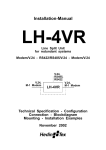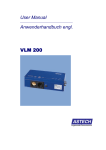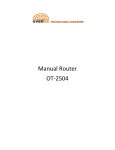Download Installation manual
Transcript
Installation-Manual LH-4VE Line Split Unit with bypass Modem/V.24 - RS422/RS485/V.24 - Modem/V.24 V.24, M-1 Modem V.24, RS485, RS422 LH-4VE V.24, M-1 Modem Technical Specification - Configuration Connection - Blockdiagram Mounting - Installation Examples January 2000 Description The line split unit divides a V.24-/M-1 modem interface into a V.24-/M-1 modem and a isolated RS422/RS485/V.24 interface. Jumper X8 and X9 set the data flow direction. Position 1-2 is for a masterslave communication (Port X1 <--> Port X2/Port X3; not Port X2 <--> Port X3). Setting 2-3 supports a token-passing protocol (Every Port sends the received data to the other ports. So the LH-4VE makes a data regenration inside a M-1 Modem connection and splits the information to a third interface. The RS422/RS485-transmitter is controlled by data or set constantly on by jumper X6. X12 extends the RS422/RS485-transmitter driver-on signal if controlled by data for better transmission-characteristics. The RS422/RS485-bus should be terminated at the end of the line. In LH-4VE this can be done by jumper X14 and X15. If the LH-4VE has a failure (power off), the interface X2 gets no data and the modem interfaces X1 and X3 are connected together. The modem status of port X1 and X3 are connected by an AND function to a relay output, to provide checking the modem interfaces within a line. TD is on/flashed --> The line split unit receives data at port X2. RD is on/flashed --> The line split unit receives data at port X1. DCD is on --> The line split unit has connection to the remote side. (If port X1 is a V.24-interface, DCD is off) Configuration The line splitter LH-4VE can be adapted by a number of different onfigurations to a variety of running conditions. After removing the top of the case the jumpers/switches are accessible. The top of the case can be removed by untying the screws. On the circuit board the switches have the following location and function. Position on the board: X5 Port 3 Fuse F250mA X15 Mo V.24 X14 1 2 3 4 Port 1 Term Mo V.24 Xa/Xc RS485/RS422 transmitter controlled by 1 2 3 Data (TD) X6 Always active X7 2-wire/4-wire transmission 135 X12 3 2 1 1 X8 X9 X8 Position OR-1 MS MM 3 2 1 2-wire (simplex/HD) 4-wire (HD/VD) 246 2W 4W X7 X6 1 2 3 X9 X14 1 2 3 4 X15 1 2 3 4 Termination X8 Transceiver terminated (2-wire) X9 No termination Receiver terminated (4-wire) Mo V24 Interface 2 3 Data flow direction Port X1 can communicate with port X2 und port X3. There is no communication possible between port X2 and port X3. (t. ex. Master-Slave protocol) Every port can communicate with every other. (t. ex. TokenPassing,- MultiMaster protocol) X12 Pos. 1-2 3-4 5-6 Delay-Time for Transmitter-Control-Signal No delay (3µs ±20%) 0,75 ms ±20% 1,5 ms ±20% Port 1 Port 3 Port X1 and Port X3 configurated as M-1 Modem-Interface OR-1: Extension card for a redundant ring system Port 1 Port 3 Port X1 and Port X3 configurated as V.24-Interface. Note: Althrough the RS232/V.24 Interface is used, the RS422/RS485-interface must be terminated by jumper X14 and X15 depending on X7. Factory setting Jumper LH-4VE Page 2/6 Connection - Assembly fixture 24V 0V PE PE 1 2 3 4 Mounting-feet 35mm-DIN-Rail (EN 50022) 1a 26 25 24 23 22 21 20 19 18 17 16 5 6 7 8 9 10 11 12 13 14 15 1c X1 X2 Screw-terminals 32a Power X3 DIN41612-Connector 32c Screw for the tab washer Total connection Screw terminal 1 2 X3 3 4 5 6 7 8 9 10 X2 11 12 13 14 15 16 17 18 19 20 21 X1 22 23 24 25 26 27 28 Power 29 30 DIN-Connection 22c 20c 22a 20a 18c 18a 16c 14c 16a 14a 12c 10c 12a 10a 32c 32a 2a 4a 2c 4c 6a 8a 6c 8c 24c 26a 32c 32c 30c 28c Jumper in position V24 Jumper in position Mo 3 - V.24 Status out (+12V pull up) M-1 Transmitter 3 TSignal Ground (SG1) M-1 Transmitter 3 T+ 3 - V.24 Data out (RD) M-1 Receiver 3 R3 - V.24 Data in (TD) M-1 Receiver 3 R+ TB/T- for 4-wire or B for 2-wire TA/T+ for 4-wire bzw. A for 2-wire RB/R- for 4-wire RA/R+ for 4-wire V.24-Data TD (in) V.24-Data RD (out) V.24-Stat. out (+12V pullup) Signal ground (SG2) Protective Earth Signal Ground (SG1) 1 - V.24 Data in (TD) 1 - V.24 Data out (RD) Signal Ground (SG1) 1 - V.24 Status out (+12V pull up) Protective Earth Signal ground (SG1) M-1 Receiver 1 R+ M-1 Receiver 1 RM-1 Transmitter 1 T+ M-1 Transmitter 1 T- Relais 1 Relais 2 Protective Earth Protective Earth Signal Ground - Power Ground 24V+ Input 24 VDC LH-4VE Page 3/6 Description Transient-Protection In LH-4VE the signal ground SG and the PE are connected together with a 0 Ohm resistor (X5). To be sure of the transient protection in any case the line splitter should be grounded. RS422/RS485-Termination This interface should allways be terminated (also if it not used). In a 2-wire system both units at the ends of the wires should be terminated. In RS422 mode the receiver with longest distance to the transmitter should be terminated. RS485-data control If the RS485-transmitter is controlled by data jumper X12 sets the Driver-ON-time for the transmitter.The transmitter is ON depending on X12 delay time after the last sending bit. In this case a termination is neccessary with pullup and pulldown resistors. The termination (X14 and X15) is realized with pullup and pulldown resistors. Bypass If a LH-4VE has a failure, the X-2 interface gets no data and the modem interfaces X1 and X3 are connected directly together. Be aware of failures by planning the distance because there is no repeater function. Interface monitor The status of the M-1 interfaces X1 and X3 are joined by an AND-function and are leaded to a relay contact (Pin 25, 26). If both interfaces detect the remote side, the contact is closed. Connection Fixing square Tab washer + DIN41612-Connector 1c 1a 32c 32a Logical connection LH-4VE V.24 or M-1 Modem X1 Bypass LH-4VE Master/ Slave X2 X3 V.24 or M-1 Modem MultiMaster V.24 or RS485, RS422 (galvanic insulated) Connection power supply Power-24V LH-4VE with assembly fixture Power-0V Power-PE 24VDC Ground Protected Earth Connection V.24-interface LH-4VE with assembly fixture 1. V.24Interface TD RD DCD SG X1-17 X1-18 X1-20 X1-19 V.24/RS232Interface 2 3 8 7 TD RD DCD SG DTE Galvanic isolated interface X2 is: TD=X2-9; RD=X2-10; DCD=X2-11; SG=X2-12 LH-4VE Page 4/6 Connection M-1 modem interface LH-4VE with assembly fixture 1. M-1 Interface T+ TR+ RPE M-1, R-1, LT-1V pp. twisted pairs X1-19 X1-20 X1-17 X1-18 X2-15 1 2 3 4 5 R+ RT+ TShield If shielded cable is used, connect the shield only at one end to avoid ground loop currents. Line connection RS422 interface LH-4VE with assembly fixture System with RS-422 interface twisted pairs X2-8 X2-7 Receiver A, T+ Transmitter B, T- Transmitter X2-6 X2-5 A´, R+ Receiver B´, R- X2-15 Shield Shield If shielded cable is used, connect the shield only at one end to avoid ground loop currents. Connection RS485 Interface LH-4VE with assembly fixture RS485 Interface A B Unit with RS485 Interface A B twisted pairs X2-6 X2-5 Shield If shielded cable is used, connect the shield only at one end to avoid ground loop currents. Transmission distance (modem interface) Cablecharacteristics 0,3 mm² 42 pF/m 600 1200 2400 21000m 15000m 10000m Speed (bps) 4800 9600 19200 38400 64000 100000 6700m 2500m 1300m 800m 300m 4000m Transmission Distance (RS422/RS485 Interface) Maximum distance: 1200m at 0-115200 bps Use unshielded twisted pair cable. The transmission distance is increased with lower capacitance and increased area. Please use screened cable in heavy interference environment but consider that the higher capacitances reduce the transmission distance. Technical Specification Transmission: Interface X1: Interface X2: Interface X3: Connector: Speed: Indicators: Isolation: Asynchronous, code independent, Full-/half-duplex or simplex EIA RS232-C and CCITT V.24/V.28 or 10mA tristate balanced current loop; M-1 compatibel EIA RS232-C and CCITT V.24/V.28, EIA RS485, V.11 (2-wire) or or EIA RS422 (4-wire) Isolated from interface 1, 2 and power. EIA RS232-C and CCITT V.24/V.28 or 10mA tristate balanced current loop; M-1 compatibel DIN 41612-connector (male) or with screw terminals on the assembly fixture 0-115,200 bps Power, TD, RD and DCD Datatransmission with optocoupler; only at M-1 interfaces Interface X2: Galvanic isolated from interface X1, X2 and power. Isolation Voltage: M-1 Interface 420 Vrms; Interface 2 to power, port X1 and X3: 420 Vrms Transient protection: Suppressor diodes and varistors Power: 24 VDC ±10% Other supplies on request Power consumption: max. 200 mA Temperature Range: 5-50° C Humidity: 0-95%RH, non-condensing Dimension (mm): 47*129*134 without assembly fixture; assembly fixture: 75*100*25 Case material: ABS-plastics, black; backplane aluminium Weight: 0.25 kg assembly fixture + 0,1kg Mounting: With an assembly fixture on the 35mm cap-rail (EN 50022) Confirm to: CE LH-4VE Page 5/6 Block diagram X5 3 X6 1 1 X7 3 4 1 2 Galvanic insulated by opto couplers 2 3 R- R+ 5V Interface 3 1>= 17 V24 Mo Optoisol. RD K1 DCD K2 >= 4 2 X9 1 18 V24 Mo K3 1 Optoisol. Mo V24 K4 3 3 1 3 4 1 X14 TD X12 20 T+ X15 3 Interface 1 0V T- 2 0V 0V 19 Sg2 12 220 2 DCD 11 1K5 +5V 0V TD 9 1K5 Ground 29 RD 10 R7 +12V_1 R+ 8 RS232/V.24 24V+ 30 PE 15 T5 RS485 T+ 6 RS422 Interface 2 2 > = K5 1 0V Mo V24 X8 +12V 2 K6 1 +12V Interface monitor and redundance extension (option) not shown Configuration Termination of RS422/RS485-Interface Mode of operation from interface X1, X2 and X3 Data flow direction RS485/RS422-transmitter controlled by data or always active Mounting The case can be mounted with the assembly fixture on the 35mm cap rail (EN50022). The assembly fixture consists of a clamp for the cap rail, a DIN 41612 connectior and four screw terminal blocks. After mounting the assembly fixture on the rail and connecting the wires to the screw terminals the case can be put on the DIN 41612 connector. Before mounting the tab washer should have a right angled position to the case. Then the unit is shifted easily downward bent onto the DIN-connector, whereby the fixing square strap rear side of housing seizes behind the printed circuit board of the assembly fixture. When the tab washer is bolt to the assembly fixture, the case has to be mounted on the rail. Installation example A master has a connection to many V.24- or RS422/RS485-slaves. V.24 V.24 [RS485, [RS485, X2 RS422] X2 RS422] V.24 M-1 Modem, LH-4VE LH-4VE 4-wire X1 X1 X3 X3 M-1 Modem, 4-wire V.24 [RS485, RS422] X2 X1 LH-4VE V.24 X3 - If a LH-4VE had a failure, the X-2 interface gets no data and the modem interfaces X1 and X3 are connected directly together. - Be aware of of failures by planing the distance because there is no repeater function. LH-4VE Page 6/6















